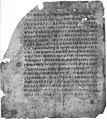Gothic language facts for kids
Quick facts for kids Gothic |
||||
|---|---|---|---|---|
| Region | Oium, Dacia, Pannonia, Dalmatia, Italy, Gallia Narbonensis, Gallia Aquitania, Hispania, Crimea, North Caucasus. | |||
| Era | 3rd–10th century, attested, until 18th century in Crimea | |||
| Language family |
Indo-European
|
|||
| Dialects |
Crimean Gothic
|
|||
| Writing system | Gothic alphabet | |||
| Linguasphere | 52-ADA | |||
|
||||
The Gothic language was an old Germanic language spoken by a group of people called the Goths. It's special because it's the East Germanic language with the most old writings that we still have today. This language slowly disappeared and was no longer spoken by the 8th century or early 9th century.
Contents
Discovering the Gothic Language
The Gothic language is now extinct, meaning no one speaks it anymore. It was used by the Goths, who were a powerful Germanic tribe. They traveled a lot across Europe, from places like modern-day Ukraine to Spain. As they moved, their language spread too.
The Importance of the Gothic Bible
One of the most important things we have from the Gothic language is a translation of the Bible. This translation was made by a bishop named Wulfila in the 3rd century. It's often called the Gothic Bible or Codex Argenteus. This Bible is super important because it's one of the longest and oldest texts written in any Germanic language. It helps us understand how Germanic languages like English and German developed over time.
When Did Gothic Disappear?
The Gothic language was spoken for several centuries. However, as the Goths mixed with other groups and their kingdoms changed, their language slowly faded away. By the 8th or 9th century, it was no longer used in daily life. A different form of Gothic, called Crimean Gothic, was spoken in Crimea for much longer, possibly until the 18th century!
Images for kids
See also
 In Spanish: Idioma gótico para niños
In Spanish: Idioma gótico para niños


